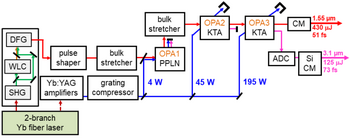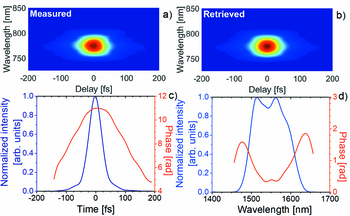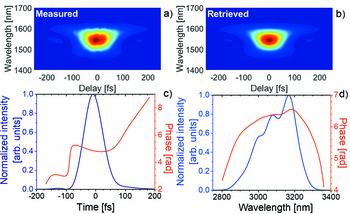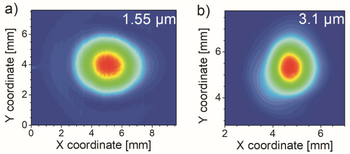1.2 Ultrafast Laser Physics and Nonlinear Optics
Project coordinators: G. Steinmeyer , T. Nagy , G. M. RossiPower scaling of diode pumped fs laser systems beyond Ti:sapphire
1.55 µm and 3.1 µm dual-beam, sub-10 cycle, 100 kHz optical parametric chirped pulse amplifier
Within this project, a dual-beam 100 kHz OPCPA system has been developed delivering an unprecedented average power at 1.55 µm in 430 µJ, 51 fs, passively CEP-stabilized pulses together with optically synchronized, 125 µJ, 73 fs pulses at 3.1 µm. In contrast to existing few-cycle mid-infrared (i.e., MIR, > 3µm), high repetition rate (i.e., >> 10 kHz) OPCPA systems operating at pulse energies above 100 µJ, our system is based on noncollinear KTA booster amplifiers seeded in the near-infrared at 1.55 µm, and a simple angular dispersion compensation technique. Despite the noncollinear amplifying geometry, KTA can be efficiently used for generating broadband, high-quality MIR pulses at high average power. The resulting OPCPA system is the first ultrafast 100 kHz table-top source delivering two, simultaneously available, optically synchronized infrared beams (i.e., >= 1.5 µm) with average powers well above 10 W in each beam and a total average power exceeding 55 W after chirp compensation. Experiments utilizing a reaction microscope have already been started. Further development will include an upgrade of the 2-branch Yb-fiber pump/seed laser, the implementation of active CEP stabilization, and nonlinear pulse compression of the 1.55 µm beam. The 1.55 µm output of this unique system will serve as the pump of a high-flux soft-X-ray source with a spectrum reaching the water window, while the 3.1 µm beam will provide optically synchronized driver pulses for strong-field interactions.



